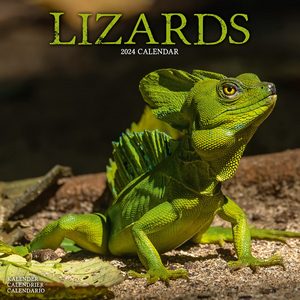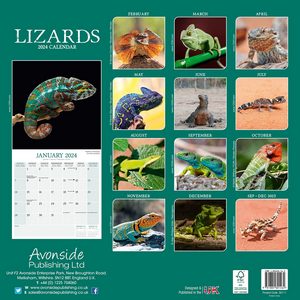|

Lizards 2024 Calendar

Lizards 2024 Calendar
|
Why buy a 2024 Lizard Calendar?
Buying a 2024 Lizards Calendar offers a range of benefits
for reptile enthusiasts and those fascinated by the diverse
world of lizards. This calendar celebrates the intriguing
and unique nature of lizards with its captivating collection
of images. Each month showcases the stunning variety of
lizard species, their vibrant colors, intricate patterns,
and fascinating behaviors. Beyond their visual appeal,
lizards are remarkable creatures known for their adaptation
to various environments and their essential roles in
ecosystems. This calendar not only adds a touch of reptilian
wonder to your space but also serves as a daily reminder of
the incredible diversity and beauty of the natural world.
Whether for personal enjoyment or as a thoughtful gift, a
2024 Lizards Calendar will bring a sense of exploration,
appreciation for nature's marvels, and a deeper
understanding of these captivating creatures throughout the
year.
More about Lizards
Lizards are a diverse group of reptiles belonging to the
order Squamata, which also includes
snakes. They can be found in various habitats around the
world, except in extremely cold regions. Here is some
general information about lizards:
1)
Physical Characteristics: Lizards come in a wide range of
sizes, from tiny geckos that can fit on a fingertip to large
monitor lizards that can grow several feet long. They have
scaly skin, clawed feet, and most species have a long tail.
Lizards have the ability to regenerate their tails if they
are lost or damaged.
2) Diversity: Lizards display
remarkable diversity in terms of appearance, behavior, and
habitat. There are over 6,000 known species of lizards,
ranging from brightly colored chameleons and geckos to
well-camouflaged skinks and anoles. Each species has its own
unique adaptations for survival and reproduction.
3) Diet and Feeding: Lizards have diverse diets, depending
on their species and habitat. They are predominantly
carnivorous, feeding on insects,
spiders, small vertebrates, and sometimes even plant
matter. Some lizards are specialized feeders, such as
herbivorous iguanas or insectivorous geckos.
4)
Behavior and Adaptations: Lizards display a wide array of
behaviors and adaptations. Some species are arboreal,
spending their lives in trees, while others are terrestrial
or even semi-aquatic. Many lizards are capable of changing
color to blend in with their surroundings or to communicate
with other individuals. Some lizards, like the frilled
lizard, can extend flaps of skin around their necks for
intimidation or to appear larger.
5) Reproduction:
Lizards reproduce sexually, with males courting females
through displays or territorial behaviors. Most species lay
eggs, which they either bury or deposit in nests, while some
give birth to live young. The incubation period varies among
species, with some eggs hatching relatively quickly, while
others may take several months.
Lizards play
important ecological roles as both predators and prey, and
they contribute to the balance of ecosystems. Their
incredible diversity and adaptations make them fascinating
creatures to study and appreciate in the natural world.
|


